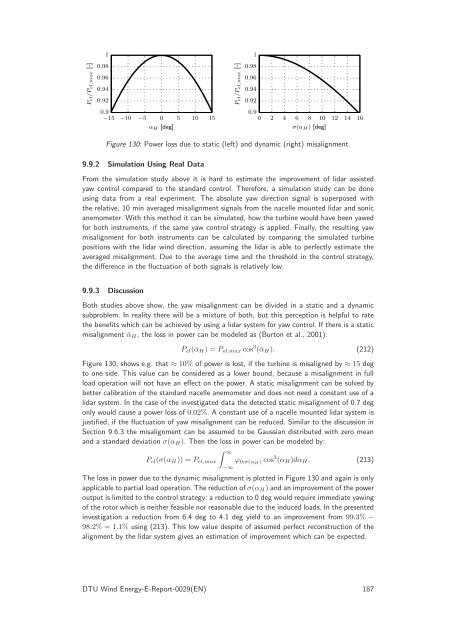Publishers version - DTU Orbit
Publishers version - DTU Orbit
Publishers version - DTU Orbit
You also want an ePaper? Increase the reach of your titles
YUMPU automatically turns print PDFs into web optimized ePapers that Google loves.
Pel/Pel,max [-]<br />
1<br />
0.98<br />
0.96<br />
0.94<br />
0.92<br />
0.9<br />
−15 −10 −5 0 5 10 15<br />
αH [deg]<br />
Pel/Pel,max [-]<br />
1<br />
0.98<br />
0.96<br />
0.94<br />
0.92<br />
0.9<br />
0 2 4 6 8 10 12 14 16<br />
σ(αH) [deg]<br />
Figure 130: Power loss due to static (left) and dynamic (right) misalignment.<br />
9.9.2 Simulation Using Real Data<br />
From the simulation study above it is hard to estimate the improvement of lidar assisted<br />
yaw control compared to the standard control. Therefore, a simulation study can be done<br />
using data from a real experiment. The absolute yaw direction signal is superposed with<br />
the relative, 10 min averaged misalignment signals from the nacelle mounted lidar and sonic<br />
anemometer. With this method it can be simulated, how the turbine would have been yawed<br />
for both instruments, if the same yaw control strategy is applied. Finally, the resulting yaw<br />
misalignment for both instruments can be calculated by comparing the simulated turbine<br />
positions with the lidar wind direction, assuming the lidar is able to perfectly estimate the<br />
averaged misalignment. Due to the average time and the threshold in the control strategy,<br />
the difference in the fluctuation of both signals is relatively low.<br />
9.9.3 Discussion<br />
Both studies above show, the yaw misalignment can be divided in a static and a dynamic<br />
subproblem. In reality there will be a mixture of both, but this perception is helpful to rate<br />
the benefits which can be achieved by using a lidar system for yaw control. If there is a static<br />
misalignment ¯αH, the loss in power can be modeled as (Burton et al., 2001):<br />
Pel(¯αH) = Pel,maxcos 3 (¯αH). (212)<br />
Figure 130, shows e.g. that ≈ 10% of power is lost, if the turbine is misaligned by ≈ 15 deg<br />
to one side. This value can be considered as a lower bound, because a misalignment in full<br />
load operation will not have an effect on the power. A static misalignment can be solved by<br />
better calibration of the standard nacelle anemometer and does not need a constant use of a<br />
lidar system. In the case of the investigated data the detected static misalignment of 0.7 deg<br />
only would cause a power loss of 0.02%. A constant use of a nacelle mounted lidar system is<br />
justified, if the fluctuation of yaw misalignment can be reduced. Similar to the discussion in<br />
Section 9.6.3 the misalignment can be assumed to be Gaussian distributed with zero mean<br />
and a standard deviation σ(αH). Then the loss in power can be modeled by:<br />
Pel(σ(αH)) = Pel,max<br />
∞<br />
−∞<br />
ϕ 0;σ(αH)cos 3 (αH)dαH. (213)<br />
The loss in power due to the dynamic misalignment is plotted in Figure 130 and again is only<br />
applicabletopartialloadoperation.Thereductionofσ(αH) andanimprovementofthepower<br />
output is limited to the control strategy: a reduction to 0 deg would require immediate yawing<br />
of the rotor which is neither feasible nor reasonable due to the induced loads. In the presented<br />
investigation a reduction from 6.4 deg to 4.1 deg yield to an improvement from 99.3% −<br />
98.2% = 1.1% using (213). This low value despite of assumed perfect reconstruction of the<br />
alignment by the lidar system gives an estimation of improvement which can be expected.<br />
<strong>DTU</strong> Wind Energy-E-Report-0029(EN) 187

















